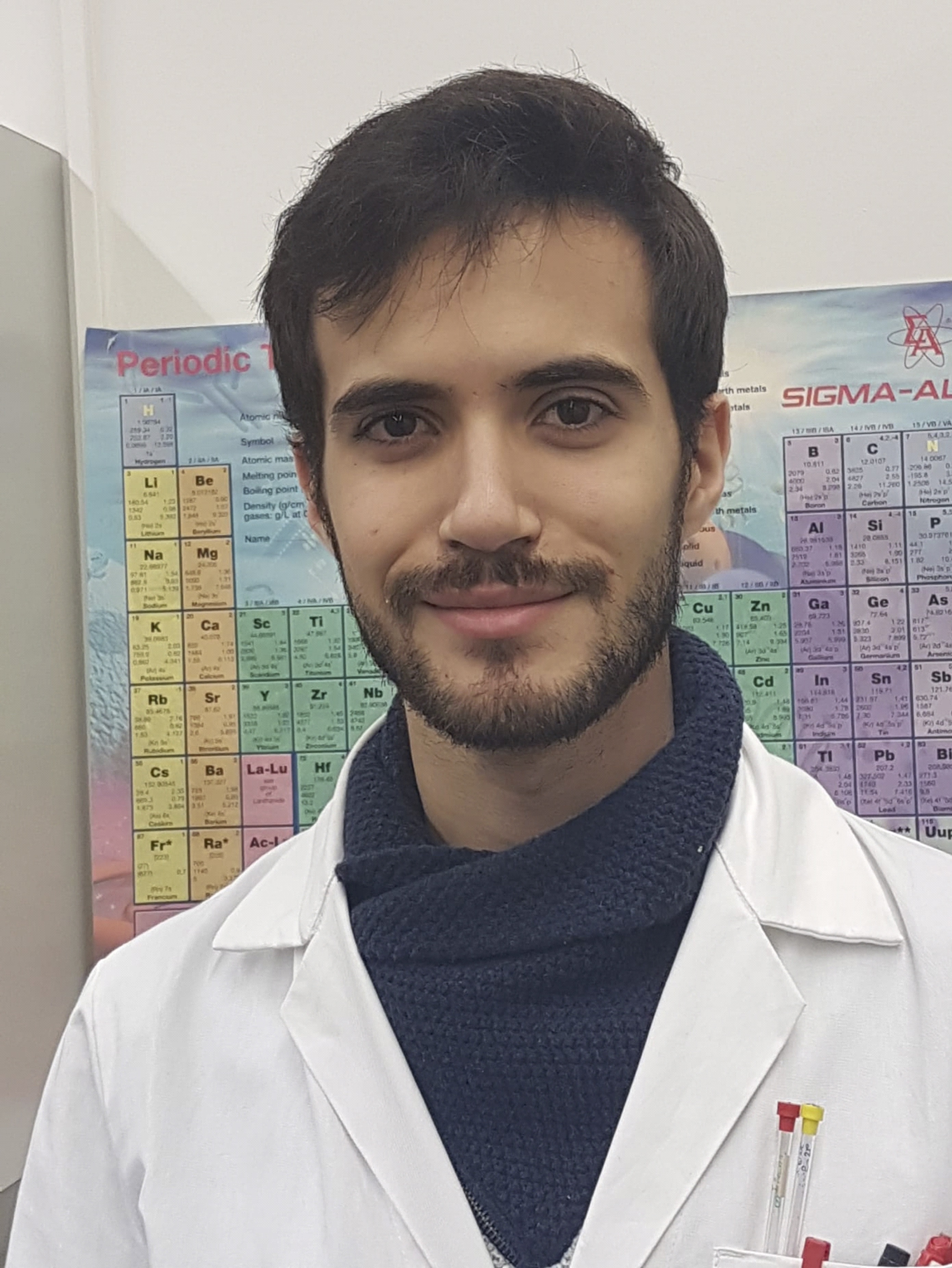Org. Synth. 2020, 97, 172-188
DOI: 10.15227/orgsyn.097.0172
Synthesis of Chiral Bisoxazoline Ligands: (3aR,3a'R,8aS,8a'S)-2,2'-(cyclopropane-1,1-diyl)bis(3a,8a-dihydro-8H-indeno[1,2-d]oxazole)
Submitted by L. Hofstra, Travis J. DeLano, and Sarah E. Reisman
1*
Checked by Sergio Cuesta-Galisteo, Jorge A. González, and Cristina Nevado
1. Procedure (Note 1)
A.
Bis((3aR,8aS)-3a,8a-dihydro-8H-indeno[1,2-d]oxazol-2-yl)methane (3) . An oven-dried 2-L three-necked, round-bottomed flask equipped with a 6.5 cm × 2.0 cm Teflon-coated elliptical stir bar is fitted with a thermometer, a reflux condenser and a rubber septum. The system is connected to a continuous nitrogen flow and then charged with
(1R,2S)-(+)-cis-1-amino-2-indanol (
1, 22.2 g, 149 mmol, 2.1 equiv),
diethyl malonimidate dihydrochloride (
2, 16.4 g, 71 mmol, 1 equiv), and 1 L of
dichloromethane (
Note 2). The system is heated to 45 °C (internal temperature 43 °C) under an atmosphere of nitrogen in an oil bath for 18 h, stirring at 600 rpm. Reaction progress is monitored by
1H NMR (
Note 3) (Figure 1).
Figure 1. Reaction setup for step A: a) equipment; b) after addition of all reagents; c) an aliquot taken
The reaction is removed from the stir plate, allowed to cool to 23 °C, and poured into to a separatory funnel (4 L). Water (1 L) is added as a single addition. The layers are separated and the aqueous layer is extracted with
dichloromethane (800 mL). The combined organic layers are dried with anhydrous
sodium sulfate (150 g, stirred for 5 min). The solution is filtered over a plug of cotton into an Erlenmeyer flask (3 L), then concentrated under reduced pressure (40 °C, 420 mmHg) into a 1 L flask (Figure 2).
Figure 2. a) reaction mixture; b) aqueous and organic layers; c) filtration system; d) filtrated solution; e) crude solid upon concentration
A 6.5 cm × 2.0 cm Teflon-coated elliptical stir bar stir bar is added to the 1 L flask containing the crude material, followed by EtOH (675 mL) (Note 4). The mixture is heated in a water bath to 80 °C with stirring. After 5 min at 80 °C, the flask is removed from the water bath (Note 5). The solution is stirred, with precipitation of the product, until it reaches 23 °C.
The resulting white solid is filtered through a medium porosity fritted filter funnel and transferred into a 250 mL round-bottomed flask. The solid is dried at 0.004 mmHg for 12 h to provide 16.4 g (70% yield) of
bis((3aR,8aS)-3a,8a-dihydro-8H-indeno[1,2-d]oxazol-2-yl)methane (
3,
Note 6) (Figure 3).
Figure 3. a) crude material dissolved in ethanol at 23 °C; b) crude material dissolved in ethanol at 80 °C; c) crude material after precipitation at 23 °C; d) crystalline solid obtained after filtration; e) solid isolated after drying
B.
(3aR,3a'R,8aS,8a'S)-2,2'-(Cyclopropane-1,1-diyl)bis(3a,8a-dihydro-8H-indeno[1,2-d]-oxazole) (4) . A flame-dried 1-L three-necked round-bottomed flask equipped with a 3.5 x 1.5 cm Teflon-coated elliptical stir bar is fitted with a thermometer, a reflux condenser and a rubber septum. The system is connected to a continuous nitrogen flow and charged with
3 (14.9 g, 45 mmol, 1 equiv) and anhydrous
THF (350 mL). The mixture is stirred at 0 °C in an ice bath for 15 min.
Sodium hydride (5.4 g, 135 mmol, 3.0 equiv) is added to the resulting solution in five approximately equal portions over 5 min, and the reaction is stirred at 0 °C for 5 min at 700 rpm (
Note 7).
1,2-Dibromoethane (5.8 mL, 67.5 mmol, 1.5 equiv) is added via syringe (10 mL) dropwise over 10 min. The reaction is removed from the ice bath and warmed to 23 °C, and then heated to 50 °C in an oil bath for 2 h (
Note 8) (Figure 4). Reaction progress is monitored by
1H NMR (
Note 9).
Figure 4. a) 3 suspended in THF; b) addition of NaH to the reaction; c) addition of 1,2-dibromoethane to the reaction; d) reaction mixture at 23 °C; e) reaction at 50 °C
The reaction is removed from the oil bath and allowed to cool to 23 °C, then cooled to 0 °C with an ice bath. The septum is removed and the excess base is quenched by adding sat. NH4Cl (300 mL) over 30 sec (Figure 5).
The reaction is diluted with water (200 mL) and the layers are separated. The aqueous layer is extracted with
dichloromethane (2 x 300 mL), and the combined organic layers are dried with anhydrous
sodium sulfate (150 g, stirred for 5 min). The solution is filtered over a plug of cotton into an Erlenmeyer flask (2 L) and then concentrated under reduced pressure (40 °C, 450-15 mmHg) into a 1 L flask. A 6.5 cm × 2.0 cm Teflon-coated elliptical stir bar is added to the 1 L flask containing the crude material, followed by
EtOAc (100 mL) and hexane (200 mL) (
Note 10). The mixture is heated in a water bath to 70 °C with stirring. After 5 min at 70 °C, the flask is removed from the water bath (
Note 5). The solution is stirred, with precipitation of the product, until it reaches 23 °C, and then cooled to 0 °C for 30 min without stirring. The resulting white solid is filtered through a medium porosity filter funnel and washed with hexane (100 mL). The white solid is transferred into a 250 mL round-bottomed flask and dried at 0.001 mmHg for 15 h to provide 11.6 g (72%) of
(3aR,3a'R,8aS,8a'S)-2,2'-(Cyclopropane-1,1-diyl)bis(3a,8a-dihydro-8H-indeno[1,2-d]-oxazole) (
4,
Note 11).
Figure 5. a) reaction mixture at 0 °C; b) quenched reaction after addition of NH4Cl(aq); c) separation of the organic layer; d) crude material in EtOAc/ n-hex (1:2 v/v); e) dried product (+)-4
2. Notes
1. Prior to performing each reaction, a thorough hazard analysis and risk assessment should be carried out with regard to each chemical substance and experimental operation on the scale planned and in the context of the laboratory where the procedures will be carried out. Guidelines for carrying out risk assessments and for analyzing the hazards associated with chemicals can be found in references such as Chapter 4 of "Prudent Practices in the Laboratory" (The National Academies Press, Washington, D.C., 2011; the full text can be accessed free of charge at
https://www.nap.edu/catalog/12654/prudent-practices-in-the-laboratory-handling-and-management-of-chemical. See also "Identifying and Evaluating Hazards in Research Laboratories" (American Chemical Society, 2015) which is available via the associated website "Hazard Assessment in Research Laboratories" at
https://www.acs.org/content/acs/en/about/governance/committees/chemicalsafety/hazard-assessment.html. In the case of this procedure, the risk assessment should include (but not necessarily be limited to) an evaluation of the potential hazards associated with
(1R,2S)-(+)-cis-1-amino-2-indanol,
diethyl malonimidate dihydrochloride,
dichloro-methane, anhydrous
sodium sulfate,
EtOH (
ethanol),
THF (
tetrahydrofuran),
sodium hydride,
1,2-dibromoethane,
NH4Cl (
ammonium chloride),
EtOAc (
ethyl acetate),
hexanes, CDCl
3 (deuterated chloroform),
ethylene carbonate, and activated alumina.
Sodium hydride is a strong base that can evolve hydrogen gas upon exposure to water or other acids.
2.
(1R,2S)-(+)-cis-1-Amino-2-indanol (97%) was purchased from Combi-Blocks and used as received.
Diethyl malonimidate dihydrochloride (<5%
ammonium chloride) was purchased from Sigma Aldrich and used as received.
Dichloromethane (99.9%) was purchased from Fisher and used as received.
3. An aliquot (1 mL) was removed and added to a vial (2 dram) and water was added (1 mL). The vial was capped and mixed by shaking. The organic layer was removed, dried over Na
2SO
4, and then concentrated by rotary evaporation. The sample was dissolved in CDCl
3 and reaction progress was determined by
1H NMR.
4.
Ethanol (200 proof) was purchased from Fisher and used as received.
5. It was found that trace amount of solids were remaining after 5 min of heating. This was not observed to affect the purity of the recovered product.
6. The desired product
3 has the following properties.
1H NMR
pdf (400 MHz, CDCl
3) δ: 3.18 (dd,
J = 18.0, 1.6 Hz, 2H), 3.28 (d,
J = 0.9 Hz, 2H), 3.39 (ddt,
J = 17.9, 7.1, 0.8 Hz, 2H), 5.35 (ddd,
J = 8.0, 7.0, 1.7 Hz, 2H), 5.58 (d,
J = 8.0, 2H), 7.22 - 7.30 (m, 6H), 7.45 - 7.48 (m, 2H);
13C NMR
pdf (101 MHz, CDCl
3) δ: 28.9, 39.8, 76.8, 83.7, 125.4, 125.6, 127.6, 128.6, 139.8, 141.8, 162.1; IR (thin film): 2986, 1657, 1479, 1458, 1349, 1321, 1260, 1002, 918, 710 cm
-1; mp 165-167 °C; [α]
26D = 392 (c = 1.0, CHCl
3); HRMS [M+H]: calc'd for C
21H
19N
2O
2 = 331.1441; found = 331.1441; Purity determined to be higher than 99% by quantitative NMR
pdf versus
ethylene carbonate as an internal standard. The submitter's yield was 67-70%. Checkers obtained 66% on half scale and 70% on full scale.
7.
Tetrahydrofuran (>99.9%) was purchased from Fisher Scientific and dried via filtration through an activated alumina column under argon.
Sodium hydride (60% in mineral oil) was purchased from Sigma Aldrich and used immediately upon receipt. Use of aged NaH can result in significantly decreased yields.
8.
1,2-Dibromoethane (98%) was purchased from Aldrich and used as received. Hydrogen gas evolved as the reaction warmed to room temperature and continued when heated to 50 °C.
9. An aliquot (0.5 mL) was removed and added to a vial (2 dram). Sat.
NH4Cl (1 mL) and CH
2Cl
2 (1 mL) were added. The vial was capped and mixed by shaking. The organic layer was removed, dried over Na
2SO
4, and then concentrated by rotary evaporation. The sample was dissolved in CDCl
3 and reaction progress was determined by
1H NMR. The reaction was complete when
3 has been consumed.
10.
Ethyl acetate (99.9%) and
hexanes (99.9%) were purchased from Fisher and used as received.
11. The desired product
4 has the following properties.
1H NMR
pdf (400 MHz, CDCl
3) δ: 1.24 - 1.38 (m, 4H), 3.19 (dd,
J = 17.8, 1.9 Hz, 2H), 3.38 (ddd,
J = 17.6, 7.0, 0.9 Hz, 2H), 5.32 (ddd,
J = 7.9, 7.0, 2.0 Hz, 2H), 5.52 (d,
J = 8.0 Hz, 2H), 7.20 - 7.24 (m, 6H), 7.42 - 7.46 (m, 2H);
13C NMR
pdf (101 MHz, CDCl
3) δ: 15.9, 18.5, 39.8, 76.5, 83.5, 125.3, 125.7, 127.5, 128.5, 139.9, 141.9, 166.0; IR (thin film): 2970, 1738, 1656, 1379, 1365, 1245, 1159, 1118, 995, 755 cm
-1; mp 161-164 °C; [α]
26D = 346 (c = 1.0, CHCl
3); HRMS [M+H]: calc'd for C
23H
21N
2O
2 = 357.1596; found = 357.1595; Purity determined to be higher than 99% by quantitative NMR
pdf versus
ethylene carbonate as an internal standard. The submitter's yield was 74-77%. Checkers obtained 68% in half scale and 72% in full scale.
Working with Hazardous Chemicals
The procedures in
Organic Syntheses are intended for use only by persons with proper training in experimental organic chemistry. All hazardous materials should be handled using the standard procedures for work with chemicals described in references such as "Prudent Practices in the Laboratory" (The National Academies Press, Washington, D.C., 2011; the full text can be accessed free of charge at
http://www.nap.edu/catalog.php?record_id=12654). All chemical waste should be disposed of in accordance with local regulations. For general guidelines for the management of chemical waste, see Chapter 8 of Prudent Practices.
In some articles in Organic Syntheses, chemical-specific hazards are highlighted in red "Caution Notes" within a procedure. It is important to recognize that the absence of a caution note does not imply that no significant hazards are associated with the chemicals involved in that procedure. Prior to performing a reaction, a thorough risk assessment should be carried out that includes a review of the potential hazards associated with each chemical and experimental operation on the scale that is planned for the procedure. Guidelines for carrying out a risk assessment and for analyzing the hazards associated with chemicals can be found in Chapter 4 of Prudent Practices.
The procedures described in Organic Syntheses are provided as published and are conducted at one's own risk. Organic Syntheses, Inc., its Editors, and its Board of Directors do not warrant or guarantee the safety of individuals using these procedures and hereby disclaim any liability for any injuries or damages claimed to have resulted from or related in any way to the procedures herein.
3. Discussion
C
2-symmetric bis(oxazolines) are a large family of chiral ligands that have been employed in a broad range of catalytic asymmetric reactions.
2,3 In 1996, Davies and coworkers at Merck Research Laboratories reported the synthesis of several bis(oxazoline) ligands from (1
R,2
S)-1-amino-2,3-dihydro-1
H-inden-2-ol (
(-)-1),
4 an intermediate in the synthesis of the HIV protease inhibitor Indinavir (
5, Figure 6).
5 Subsequently, they reported that the complex generated from (3a
R,3a'
R,8a
S,8a'
S)-2,2'-(cyclopropane-1,1-diyl)bis(3a,8a-dihydro-8H-indeno[1,2-d]-oxazole) (
(-)-4)
and Cu(OTf)
2 catalyzes the Diels-Alder reaction between 3-acryloyloxazolidin-2-one and cyclopentadiene in >90% yield and 96% ee (Figure 7, i).
6 Since these initial disclosures,
4 has been used as a chiral ligand for numerous Lewis acid-catalyzed and transition metal-catalyzed reactions. A selection of representative examples is presented here. A comprehensive review of the applications of
1 in asymmetric catalysis through 2006 can be found in reference 4.
Figure 6. (1S, 2R)-cis-1-Amino-1-indanol containing compounds
Soon after the initial disclosure of
4, Sibi and coworkers reported that the complex generated from MgI
2 and (-)-
4can induce asymmetry in the addition of alkyl radicals to α,β-unsaturated imides (Figure 7, ii).
7 In subsequent studies, Sibi and team have developed a variety of enantioselective 1,4-addition reactions, of both carbon centered radicals and of polar nucleophiles (see Figure 7, iii and iv, for two examples).
8 During the same period, the process chemistry team at Abbott Laboratories demonstrated that magnesium complexes of (-)-
4 catalyze the conjugate addition of 1,3-dicarbonyl compounds to nitroalkenes.
9 In a more recent example, Waser and Hari have demonstrated that the complex generated from CuCl and (+)-
4 catalyzes the reaction between alkynyl hypervalent iodine species and α-diazo esters.
10
Figure 7. Examples of Lewis acid-catalyzed reactions employing 4 as a chiral ligand
Over the last decade,
4 has emerged as a valuable ligand for transition metal-catalyzed cross-coupling reactions. Our laboratory has used Ni complexes of (+)-
4 to catalyze the Ni-catalyzed enantioselective reductive alkenylation of benzylic electrophiles (Figure 8, i).
11 When α-chlorobenzyl silanes are used, the corresponding enantioenriched allylic silanes can be prepared (Figure 8, ii).
12 Liu and coworkers have used Cu complexes of
4 for a variety of enantioselective cyanation reactions, including the difunctionalization of styrenes
13 (Figure 8, iii) and the decarboxylative cyanation of NHP esters (Figure 8, iv).
14 The wide range of transformations, under a variety of different modes of catalysis, demonstrate the utility of
4 as a chiral ligand.
Figure 8. Examples of transition metal-catalyzed cross-coupling employing 4 as a ligand
The procedure reported here is a two-step synthesis of bis(oxazoline) ligand
4 from commercially available
1, adapted from our previous reports.
11,12 This synthesis proceeds in good yield and requires no chromatographic purifications. Although we highlight the synthesis of
4, a variety of other cyclopropyl-linked bisoxazoline ligands can be synthesized using this method.
15,16,17,18,19
Appendix
Chemical Abstracts Nomenclature (Registry Number)
(1R,2S)-(+)-cis-1-Amino-2-indanol: 1H-Inden-2-ol, 1-amino-2,3-dihydro-, (1R,2S)-; (1) (136030-00-7)
Diethylmalonimidate dihydrochloride: Propanediimidic acid, 1,3-diethyl ester, hydrochloride (1:2); (2) (10344-69-1)
Sodium hydride: Sodium hydride; (7646-69-7)
1,2-Dibromoethane: Ethane, 1,2-dibromo-; (106-93-4)

|
Sarah E. Reisman earned a B.A. in Chemistry from Connecticut College in New London, CT, working in the laboratory of Prof. Timo Ovaska, and her Ph.D. in chemistry from Yale University, conducting research in the area of natural product synthesis with Prof. John L. Wood. As an NIH post-doctoral fellow, Sarah pursued studies in the field of asymmetric catalysis working with Prof. Eric Jacobsen at Harvard University. In 2008, Sarah joined the faculty at the California Institute of Technology where she is now a Professor of Chemistry and a Heritage Principal Investigator. |

|
Julie Hofstra received her B.S. in Chemistry from California State University, Fullerton in 2014. While at CSUF, Julie conducted atmospheric chemistry research in the laboratory of Professor Paula Hudson and organic chemistry research in the laboratory of Professor Peter de Lijser. In 2014, Julie joined the laboratory of Professor Sarah Reisman at the California Institute of Technology. Her work focuses on the development and mechanistic studies of nickel-catalyzed reductive cross-coupling reactions. |

|
Travis DeLano received his B.S. in Chemistry from Northeastern University in Boston, Massachusetts in 2017. While at Northeastern, Travis conducted medicinal chemistry research in the lab of Professor Michael Pollastri, and worked at both Takeda Pharmaceuticals and Vertex Pharmaceuticals. Travis is currently a graduate student in the lab of Sarah Reisman at the California Institute of Technology, where he is focused on the development of asymmetric nickel-catalyzed reductive cross-coupling reactions. |

|
Sergio Cuesta-Galisteo was born in Madrid in 1995. He obtained his Bachelor and Master Degree in Chemistry in the Universidad Complutense de Madrid under the supervision of Prof. Nazario Martin. He did a short internship at University of Zurich in the group of Professor Cristina Nevado, where he is currently doing his Ph.D. |

|
Jorge A. González was born in Xalapa, Mexico. He completed his Undergraduate Degree in Chemistry at the National and Autonomous University of Mexico in 2011. He obtained his Ph.D. at the University of Edinburgh in 2016. He is currently a postdoctoral associate research associate in the group of Professor Cristina Nevado. |
Copyright © 1921-, Organic Syntheses, Inc. All Rights Reserved